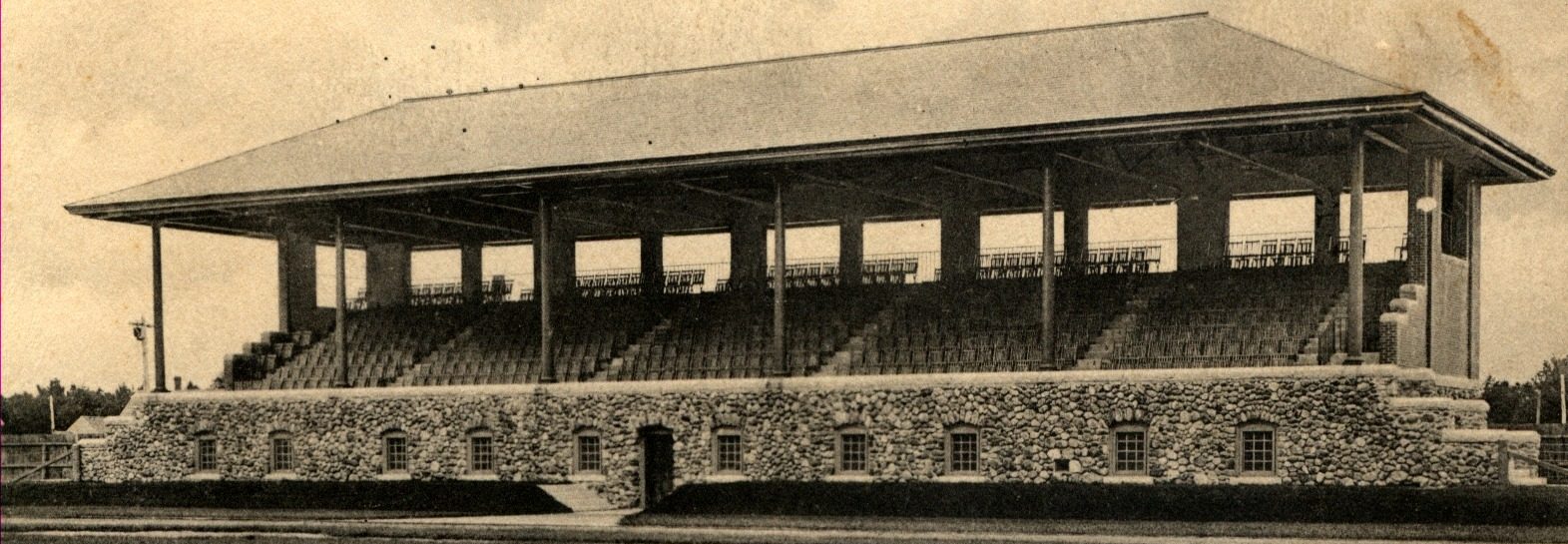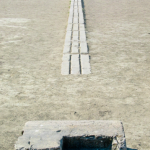Introduction
While studying ancient stadiums, the question arises regarding how to delineate a site as a ruin versus a structure that should be renovated and reused. Both sites—ruins and renovations—serve as a form of memorialization. Ruins are often preserved in their current state, and our society has placed value on these places, attracting tourists from around the world who wish to experience the devastating beauty of the space’s decay. Renovated sites serve a more functional purpose, allowing people to appreciate a structure’s past by living and experiencing it for its intended purpose.
Athletic venues pose a unique space to study ruins and renovations due to their grandiose size and natural tendency to attract people worldwide. In this section, I will investigate the Ancient Greek site of Olympia as well as the Panathenaic stadium in Athens.
Olympia
The Ancient Greek Olympics’ meaning extended further than just playing sports, they were also seen as a religious festival. While there was a sanctuary for Zeus on the site, the Greeks were also polytheistic: there were more than 70 altar options for sacrifice. The first Olympics were held in 776 BCE in honor of Zeus. The games were certainly affiliated with religion, and many men participated in them, particularly soldiers.
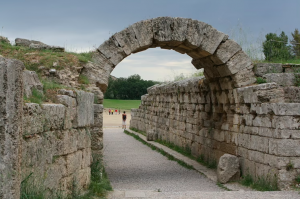
The Krypte and entrance to the stadium. Courtesy Worldhistory.com
While the site of Olympia is vast and contains many ruins, the stadium was an especially holy place for the ancient Greeks, as it was the space in which the sporting events were dedicated to Zeus. The official entrance to the stadium was the Krypte, a stone vaulted passageway that connected the area to the other part of the sanctuary. The stadium itself had mud seats that could sit 40,000 spectators, and a special area was designated for the officials’ seating.
The stadium that was built to host the Olympic Games in 776 BC is the oldest known stadium. Thousands of citizens flocked to Greece to watch the stadion, a 200-yard foot race. The stadium was made of packed clay and had a starting line made of flat stones that remain there to this day.
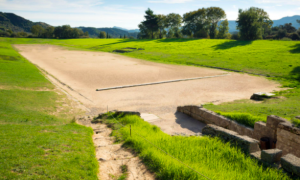
The 200-yard long Ancient Stadium of Olympia. Courtesy worldhistory.org.
The site today attracts tens of thousands of visitors each year. By preserving the space in its state of ruin, Olympia and its stadium show the original rudimentary nature of the Olympic Games. Of course, the site and ruins are astounding, but had it been renovated, the authenticity of the area would have been lost. In this manner, the preserved ruins serve as a memorial to the Ancient Greek Olympics, capturing the beginning of an era of athletic history.
- The Hellanodikai served as seats for the judges of the events while the other spectators would sit along the hillside. Courtesy Ancient-Greece.org.
- The marble start line in the Olympic stadium remains intact today. The notches that appear were for the athlete’s feet. Courtesy Ancient-Greece.org.
The Panathenaic Stadium

Construction of the stadium for the 1896 Olympic Games. Courtesy Panathenaic Stadium.
The Panathenaic Stadium in Athens holds a rich history that introduces a variety of examples of memorialization through renovation and functionality. The stadium is a symbol of durability, as it has been in and out of use for nearly two millennia. With additions and renovation over the years, the stadium has been able to carry out its intended purpose—hosting athletic events and welcoming people worldwide.
Built in 330 BC under the influence of Lycurgus, the great orator, the stadium was made as part of the infrastructure for the Panathenaic Games. The original shape was rectangular, but in the 2nd century AD, under the rule of Emperor Hadrian, Athens received great funding to revamp buildings and public projects. The stadium underwent its first renovation, changing into a horseshoe—a typical shape during Roman times. This new design increased its spectator capacity significantly to nearly 50,000 people. In addition, marble from Mt Penteli was used to cover the seats, making the stadium stand out in comparison to all others.
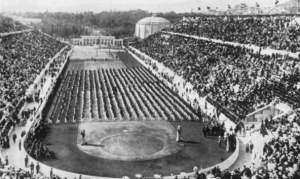
Stadium during the 1896 Olympic Games. Courtesy Britannica.
Similar to what happened with the Colesseum, the stadium overtime was stripped of its valuable materials for other purposes and projects around the city. This custom was common, and the redistribution and repurposing of materials is, in some ways, another form of commemoration—parts of a building are given a second life as they are manifested in new projects.
By the 4th century, the stadium was abandoned, and it was not until 1869 that it was excavated. While it lay dormant for many centuries, the Panathenaic Stadium was brought back to life to host the first modern Olympic Games in Athens in 1896. New marble seats were added, and the original horseshoe shape was maintained.
Since the first modern Olympics, the stadium has hosted many events including sporting competitions and concerts. It also serves as the finishing line of a marathon in Athens. Nearly a century after it hosted its first Olympics, the Panathenaic stadium welcomed the 2004 games, serving again as the focal point of world athletic competition. It is also the location of the Olympic flame.

Stadium during the 1896 Olympic Games. Courtesy Panathenaic Stadium.
The history of the Panathenaic Stadium demonstrates durability and resilience. The sites’ multiple renovations and most recent restoration have allowed for its ancient legacy and athletic celebration to live on. As people today visit the stadium as tourists or spectators, they are engraving themselves into collective memory. The space’s enduring functionality reminds us of the importance of remembering the past, as it gives us meaningful context for our present and future, particularly in regards to athletics.

Image of the stadium today. Courtesy National Geographic.
Works Cited
“Athens 1896 Olympic Games.” Encyclopædia Britannica, Encyclopædia Britannica, Inc., 30 Mar. 2021, www.britannica.com/event/Athens-1896-Olympic-Games. Bednarz, Christine. “Visit the Panathenaic Stadium in Athens That Hosted the First Modern Olympics.” Travel, National Geographic, 3 May 2021, www.nationalgeographic.com/travel/article/things-to-do-olympic-panathenaic-stadium. Cartwright, Mark. “Ancient Olympic Games.” World History Encyclopedia, World History Encyclopedia, 14 May 2021, www.worldhistory.org/Olympic_Games/. Sakoulas, Thomas. “Olympia Archaeological Site.” Ancient Olympia, ancient-greece.org/archaeology/olympia.html. “Sports Stadiums Past and Present.” Allsite Structures, 19 Nov. 2020, allsitestructures.com/history-sports-stadiums/. “Welcome to the Ancient Olympic Games.” International Olympic Committee, 27 Apr. 2021, www.olympic.org/ancient-olympic-games.
